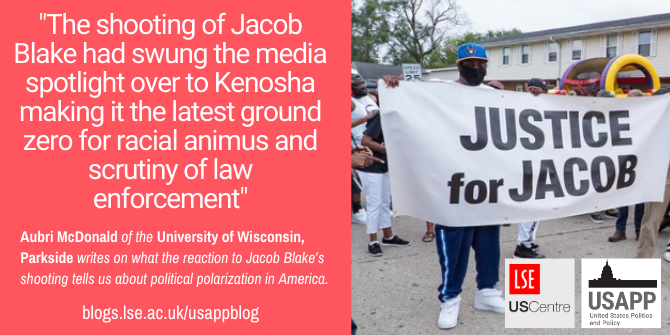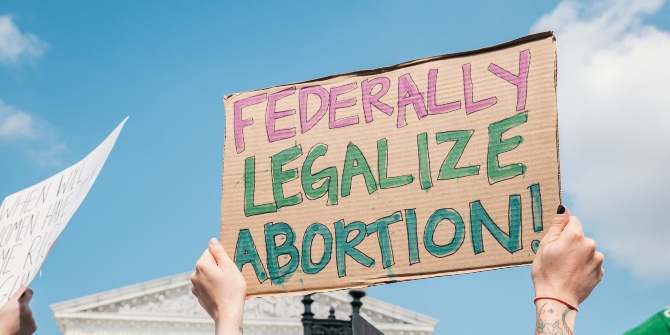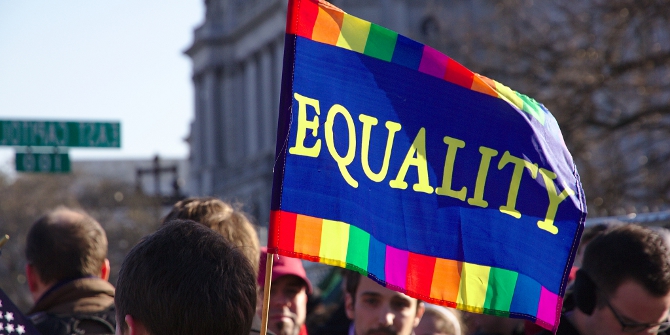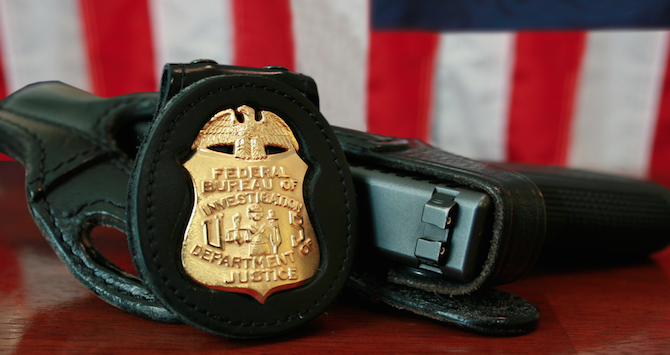 Jacob Blake’s shooting by police in August in Kenosha, Wisconsin, and the subsequent local and national protests in response have generally been covered by the national media along partisan lines, especially in light of the 2020 presidential election. Aubri McDonald writes that by examining how events such as these are understood, or framed, we can start to better understand opposing views, and potentially reduce political polarization.
Jacob Blake’s shooting by police in August in Kenosha, Wisconsin, and the subsequent local and national protests in response have generally been covered by the national media along partisan lines, especially in light of the 2020 presidential election. Aubri McDonald writes that by examining how events such as these are understood, or framed, we can start to better understand opposing views, and potentially reduce political polarization.
News of the Jacob Blake shooting on 23 August came in the form of a text from a friend and my former PhD advisor. It read: “Polarization Comes to a Classroom Near You.” Attached was a news story with the headline: “Kenosha, Wisconsin – White Cop Shoots Unarmed Black Man… Seven Times, Point-Blank.” “No way” I thought. I had left Chicago for a more peaceful existence. I’m a professor at the University of Wisconsin, Parkside in Kenosha, a smallish town along Lake Michigan. The university is down the road from where the Jacob Blake shooting occurred and where two protesters were killed two days later. The start of Fall semester was less than two weeks away. My Fall class lineup includes Police & Society and courses that deal with Race & Crime and Media & Crime. The shooting of Jacob Blake had swung the media spotlight over to Kenosha making it the latest ground zero for racial animus and scrutiny of law enforcement. And much like the rest of society my students naturally have opposing perspectives with some strongly supporting Black Lives Matter while others have strong support for police. The polarization creates a spiral of silence where students are discouraged from expressing their views out of fear of being judged or attacked. My challenge is to facilitate productive discourse and it has to start with addressing polarization.
‘White-Cop-Shoots-Unarmed-Black-Man’ is an instantly recognizable media frame. It symbolizes police violence and racial injustice as it brings to mind the recent deaths of Breonna Taylor in Louisville, Kentucky and George Floyd in Minneapolis, Minnesota and media stories of others who have lost their lives during encounters with police. The frame is not new. It gained prominence in the media and public consciousness following the 2014 shooting death of Michael Brown, a Black 18-year-old by a white police officer in Ferguson, Missouri. Images of his body lying in the street and descriptions of the shooting spread far and wide on social media sparking protests.
The image of a police officer kneeling on George Floyd’s neck was still a fresh wound in the public psyche when the video showing an officer shooting Jacob Blake in the back went viral. Blake survived the shooting and is reportedly paralyzed. Widespread protests and calls to ‘defund’ the police ensued against the backdrop of a pandemic that had already heightened anxieties. The upcoming presidential election along with partisan media coverage has only intensified the polarization. A recent poll found that when it comes to racial protests, Americans are increasingly polarized with sharp divisions along party lines.
Kenosha Burning
The response to Blake’s shooting was described by local news as a “body blow” to Kenosha. Fireworks, water bottles and bricks were thrown at police officers in riot gear. Storefront windows were smashed, businesses looted and buildings set on fire. Thirty businesses were destroyed or damaged with the majority of the destruction in Kenosha’s mostly Black Uptown neighborhood. Many of the businesses there were family-owned and had been there for decades. A car dealership was set on fire. Residents reported hearing car tires exploding throughout the night as the cars burned. On the third night of unrest, dozens of armed individuals stationed themselves in front of businesses to prevent property damage. One of these individuals was 17-year-old Kyle Rittenhouse. Rittenhouse, who travelled to Kenosha from his home in Antioch, Illinois, had a semi-automatic rifle which he used to shoot three protesters, killing two of them.
Race, Police & Community
The initial reaction to the Jacob Blake shooting illuminated a history of racial tension and police-community tensions in Kenosha. Some residents noted that racism in Kenosha is “normalized.” The 2004 shooting of Michael Bell, Jr was significant in eroding distrust in police for Kenosha residents as it was suspected police engaged in a cover-up. Bell, a white 21-year-old, was killed when police shot him in the head during a traffic stop where police claimed Bell had gotten ahold of an officer’s firearm. Bell’s shooting changed the way deaths involving police were investigated. Instead of the Kenosha Police Department investigating themselves, the Wisconsin Department of Justice would investigate such incidents. More recently, the ACLU called for the resignation of Kenosha Police Chief Daniel Miskinis and Kenosha County Sheriff David Beth because deputies had not arrested Kyle Rittenhouse amid the chaos, for comments Chief Miskinis made regarding Rittenhouse’s victims, and for comments Sheriff Beth made in the past.

“DSC09509” by Milwaukee Teachers’ Education Association (MTEA) is licensed under CC BY NC 2.0
Media, Politics & Polarization
Polarization was evident in the media as news outlets theorized what the Blake shooting and the destruction that followed might mean for the upcoming presidential election. Trump and Biden both visited Kenosha. While Trump pledged his support for law enforcement, Biden met with Blake’s family and called for the officers to be charged. Wisconsin is one of a dozen battleground states where the state’s ten electoral votes could go to either presidential candidate. Media outlets signaled political loyalties in their coverage surrounding the Blake shooting fueling polarization among the public. Liberal leaning media outlets downplayed the protests. A CNN reporter described the Kenosha riots as ‘Fiery But Mostly Peaceful’ as a building behind him was engulfed in flames. CNN, The New York Times and Politico warned that the unrest in Kenosha could encourage Wisconsin residents to vote for Trump because they felt as though Democratic leaders namely Kenosha Mayor John Antaramian and Wisconsin Governor, Tony Evers weren’t doing enough to control the rioting and violence. Right-leaning media and President Trump sided with Rittenhouse. Tucker Carlson on Fox News praised Rittenhouse, a Trump supporter, for maintaining order. President Trump suggested Rittenhouse acted in self-defense.
Polarization in the Classroom: Can It Be Overcome?
The rhetoric surrounding Blake’s shooting and similar incidents offered my classes valuable lessons in media framing and confirmation bias. Framing refers to a communication theory that explains how wording, images, and associations can influence a particular interpretation. Confirmation bias involves favoring information that confirms your existing beliefs or biases. It’s perhaps crucial now more than ever to critically evaluate media, especially given its power to produce and reinforce bias and spread misinformation. This is especially so given that most people in the US get their news from social media. Understanding how people process, store, and apply information about events, issues and people informs how stereotypes are created and helps us identify and confront our own biases.
Since my students hold deeply conflicting frames, as does society at large, my challenge was figuring out a way to reduce polarization and safely facilitate civil discourse. My attempt to address polarization involved conducting an anonymous, live poll on the first day for each of my classes. The poll offered a way to open up discussions about the Blake and Rittenhouse shootings and talk about the concept of framing. I asked two questions: “1) Jacob Blake shooting… A. Justified or B. Racially-motivated,” and “2) Kyle Rittenhouse… A. Domestic Terrorist or B. Patriot.” The answer choices represented opposing frames for each incident. I then prompted students to identify information that does not fit each frame, or discrepant information. This processing gets students to recognize facts that don’t fit their particular frames of the Blake and Rittenhouse shootings. Critiquing their own frame helps students recognize that frames exist, that they are different from facts, and helps them understand the opposing view. In a similar vein, for my Police & Society class I designed a Community Based Learning project that involves students interviewing a police official and activist about ‘defunding’ police. Feedback from my students and civil discussions in my classes are encouraging and suggest these approaches may be helpful in addressing polarization.
Beyond the Classroom
Overcoming polarization requires admitting some facts don’t fit your own frame and therefore respecting others opinions and frames. The clashing frames of “lawless rioting and looting” and “systemic racism and racist police” each marshal those facts that support their frame. The Black Lives Matter movement and liberals are increasingly associated with the former while police officers and conservatives are associated with the latter. In our current, highly polarized environment, we need to recognize that our views are not necessarily absolute truth; there are facts that support the other side. Framing can be a useful tool for scrutinizing our own perspectives and finding common ground with others who have opposing viewpoints. If we can minimize polarization in the classroom in Kenosha, maybe there is hope for the rest of America.
Please read our comments policy before commenting.
Note: This article gives the views of the author, and not the position of USAPP–American Politics and Policy, nor of the London School of Economics nor the University of Wisconsin Parkside.
Shortened URL for this post: https://bit.ly/34il8IT
About the author
 Aubri McDonald, PhD – University of Wisconsin, Parkside
Aubri McDonald, PhD – University of Wisconsin, Parkside
Aubri McDonald earned her PhD in Criminology from the University of Illinois in Chicago and is an Assistant Professor in the Criminal Justice Department at University of Wisconsin, Parkside.






